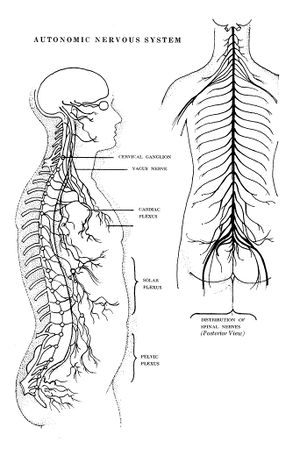Neuromyelitis Optica
Top Contributors - Kehinde Fatola, Reem Ramadan, Nikhil Benhur Abburi, Kim Jackson and Leana Louw
Introduction[edit | edit source]
Neuromyelitis Optica (NMO) or Devic's Syndrome is a rare autoimmune disease of the Central Nervous System (CNS) that mainly affects the optic nerve (CN II), a paired nerve which conveys visual impulses to the lateral geniculate nucleus of the brain[1], and spinal cord. It's a demyelinating disorder thus myelin, an insulator of the CNS is the primary focus of the disease[2]. This condition affects more prevalent in women than men[3].
There are two types of NMO:
- Relapsing form: This form is characterized by periodic flare-ups with some recovery and another surge later. 80% of affected patients are female.[3]
- Monophasic form: This form is characterized by a single attack that lasts a month or two months. Men and women get this type equally[4].
Pathological Process[edit | edit source]
Neuromyelitis Optica is caused by a highly specific serum immunoglobulin (Ig)G autoantibody (NMO-IgG) which targets the most abundant astrocytic water channel aquaporin-4 (AQP4) causing the activation of other parts of the immune system and thus resulting in the inflammation and damage to cells as well as the demyelination of the optic nerve (optic neuritis) and the spinal cord (myelitis)[5] [3]. NMO-IgG/AQP4-antibodies are present in up to 80% of patients with NMO [6].
Clinical Presentation[edit | edit source]
Patients with NMO experience attacks that come and go. These attacks vary from mild to severe and can last from days to months ad in some cases these attacks may last and become permanent. The symptoms are broken down into three categories:
Optic neuritis occurs due to the inflammation of one or both of the optic nerves. Some of the optic neuritis symptoms include:
- Decreased visual acuity
- Visual field defects
- Color blindness
- Eye pain
Myelitis which occur due to the inflammation of the spinal cord and some of it's symptoms include: [3][7]
- Muscle weakness
- Decreased sensation
- Incontinence
- Paraparesis
- Quadriparesis
- Vomiting
- Pains
Diagnostic Procedures[edit | edit source]
The following can be used to diagnose the condition; [3]
- Neurological examinations to examine movement, muscle strength, coordination, sensation, memory and thinking (cognitive) functions, and vision and speech. An ophthalmologist also may be involved in the examination.
- Magnetic Resonance Imaging (MRI) of the brain and spinal cord.
- Blood test / spinal tap (lumbar puncture) to test for antibodies which might indicate the presence of the disease.
- Stimuli response test to learn how well the brain responds to stimuli such as sounds, sights or touch.
The tests helps to find lesions or damaged areas in the nerves, spinal cord, optic nerve, brain or brainstem.
Differential Diagnosis[edit | edit source]
- Multiple sclerosis
- Guillain Barre Syndrome
- Disc herniation
- Transverse myelitis
- Parainfectious myelitis
- Tumour
- Epidural or subdural hematoma
- Epidural and/or paraspinal abscess
Medical Management / Interventions[edit | edit source]
The disease is not curable, however, proper management may ensure the patient live good quality life. Medical intervention may involve; [7]
- Intravenous corticosteroids
- Immunosuppressants
- Plasmapheresis
Physiotherapy Management[edit | edit source]
As stated earlier, no known cure has been found for the disease yet. However, Physiotherapy management is essential for possible future remission as interventions focuses on the clinical presentations which are most times physical disabilities. Physiotherapy interventions may include;
- Gait training
- Wheelchair training
- Pain reduction / management
- Transfers
- Reduce risk of pressure ulcers
- Aid control to spasticity
- Strengthening programme
- Stretching programme
References[edit | edit source]
- ↑ Smith AM, Czyz CN. Neuroanatomy, Cranial Nerve 2 (Optic). InStatPearls. StatPearls Publishing. 2022
- ↑ Kowarik MC, Soltys J. Bennett JL. The Treatment of Neuromyelitis Optica. Journal of Neuro-Ophthalmology. 2014. 34 (1): 70–82
- ↑ 3.0 3.1 3.2 3.3 3.4 Barkhof F, Koeller KK (February 2020). 13 Demyelinating Diseases of the CNS (Brain and Spine) . In: Hodler J, Kubik-Huch RA, von Schulthess GK (eds.). Diseases of the Brain, Head and Neck, Spine 2020–2023: Diagnostic Imaging . IDKD Springer Series. Cham, Switzerland: Springer. pp. 165–176.
- ↑ Neuromyelitis Optica. Neuromyelitis Optica | Johns Hopkins Medicine. Available at: https://www.hopkinsmedicine.org/health/conditions-and-diseases/neuromyelitis-optica (accessed 17/2/2023)
- ↑ Paul F, Jarius S, Aktas O, Bluthner M, Bauer O, Appelhans H, Franciotta D, Bergamaschi R, Littleton E, Palace J, Seelig HP. Antibody to aquaporin 4 in the diagnosis of neuromyelitis optica. PLoS medicine. 2007 Apr;4(4):e133.
- ↑ Waters P, Jarius S, Littleton E, Leite MI, Jacob S, Gray B, Geraldes R, Vale T, Jacob A, Palace J, Maxwell S. Aquaporin-4 antibodies in neuromyelitis optica and longitudinally extensive transverse myelitis. Archives of neurology. 2008 Jul 14;65(7):913-9.
- ↑ 7.0 7.1 Wingerchuk DM, Lennon VA, Pittock SJ, Lucchinetti CF, Weinshenker BG. Revised Diagnostic Criteria for Neuromyelitis Optica. Journal of Neurology. 2006. 66 (10): 1485–9.







